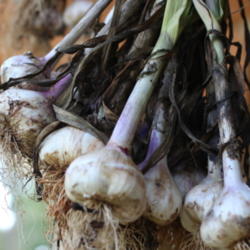
On a small farm at the edge of northern California's wine country, a robust and cheerful 75-year-old gardener named Chester Aaron lovingly cultivates an extraordinary collection of specialty garlics. Near the tiny town of Occidental (2 hours north of San Francisco), where coastal fogs moderate both summer and winter temperatures, Aaron raises and tends 81 named varieties of garlic, ranging from delicately flavored golden French varieties to hearty Russian strains with rich burgundy cloves.
A retired English professor and respected author, Aaron is a dedicated enthusiast of this ancient and aromatic herb. At an age when most people are slowing down, he happily toils over the cultivation, harvesting, and marketing of 12,000 heads of the world's finest and rarest garlics. His fragrant avocation has provided him with plenty of contact with other garlic enthusiasts, and lots of outdoor exercise, not to mention two bestselling books from Ten Speed Press, Garlic is Life (1996; $15) and The Great Garlic Book (1997; $15), and a poster (also from Ten Speed) with photographs of 40 varieties he grew.
Partly because of Aaron, gardeners today can chose between more than 300 different varieties of garlic, each distinct in some specific way: bigger or smaller, hotter or milder, pale white to glorious red, more or less pungent, more round or more elongated, more or fewer cloves, and on and on. The plant is, after all, thousands of years old and has moved with and adapted to pretty much wherever people have gone.
To talk about garlic flavor is like talking about the flavor of wine. The variations are sometimes major, sometimes extremely subtle, and often personal. Aaron's short list of favorites appears at the end of this article.
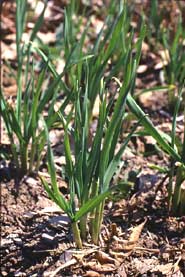
After more than a decade of planting and harvesting, Aaron has amassed a multitude of garlic-growing tricks. Here are his tips for growing, gathering, and curing any type of garlic in a typical home garden. Though flavor does vary from one variety of garlic to another, and the flavor of a variety often changes from region to region and season to season, the growing and harvesting methods apply almost universally.
Garlic Growing Know-HowThere are three problems when growing garlic: drainage, gophers, and onion root maggots. Though the plants love regular irrigation, they don't like heavy or waterlogged soil. In Aaron's experience, the roots need 16 to 24 inches of well-drained soil. After rain or irrigation, if water is visible when you stick your finger in the soil, the soil is too wet, and the garlic will rot. Aaron's farm has few drainage problems, but his land, like most gardens in his area, teems with ravenous gophers who seem to crave garlic as avidly as any gourmand.
Onion root maggots can also be a problem. These maggots of tiny flies lay eggs in soil around developing cloves. The maggots then find the garlic and tunnel inside, spoiling it. Onion maggots thrive in alkaline soil.
Aaron's solution to all three problems is to grow garlic in raised beds. He built 60 raised beds, each one about 4 feet wide and 10 feet long and spacious enough for 130 to 180 garlic plants, depending on the variety.
The rough-sawn 2-by-12 redwood boards he uses are unwieldy, so it's best to build the boxes in the garden, close to the desired site. Here's how:
On level ground, butt the boards to form a rectangle with the 4-foot pieces across the ends of the 10-foot ones. Join each corner with four 16d (16-penny) hot-dipped galvanized box nails. (Pre-drilling nail holes is advised if you're using wood prone to splitting.) If redwood is not an option where you live, use similarly rot-resistant eastern or western red cedar, inexpensive hemlock, or consider the ersatz wood planks made of recycled plastic. To foil gophers (which are less of a problem in the northeastern United States), Aaron stretches 4-foot-wide 1/2-inch-mesh aviary wire across the bottom of each box, then staples it in place.
Next, fill each box with a fertile, fast-draining soil mix. Aaron's usual mixture, called Spring Garden Mix, blends topsoil with well-rotted horse or cow manure or compost, sand, and finely shredded bark. Check with your local garden center for a good source of bulk soil mix and ask for a blend similar to the one Aaron uses.
Before buying a soil mix, Aaron recommends checking with other buyers, if possible, about the reputation of the supplier's soil mix, in particular regarding freedom from weed seeds. Also check to be sure the soil mix is slightly acidic, pH 6 to 7. Soils that are alkaline and have pH 7 and above are more favorable to onion root maggots.
Because the fall season in his area can be dry until November and there is little rain after mid-April, Aaron must irrigate his crop so that it will produce full-sized heads. He finds that drip irrigation is the most efficient way to water. For each 4-foot-wide box, Aaron uses four 10-foot lines of drip-irrigation tubing equally spaced across the box's width. He prefers in-line emitter tubing with 1/2-gallon per hour (gph) emitters preinserted inside the tubing every 12 inches. The four lines of tubing are linked together at both ends of the box with more in-line tubing, and seven boxes can be connected together via solid pipe (3/4-inch solid, schedule 40 PVC irrigation pipe) as one watering unit. During the warmer parts of late spring, Aaron will irrigate for a mere 5 to 10 minutes every morning when there's no rain, or about 2 to 4 gallons (48 emitters at 1/2 gph, or a total of 24 gph) per box.
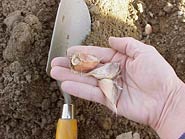
In Aaron's cool-summer, mild-winter area, planting is best done in the fall, from early October through early December. In cold-winter areas, he recommends planting in September or early October so that the roots can grow down several inches while the soil is still permeable.
Choose the cleanest, firmest, largest heads, and break them into individual cloves. Discard all broken, discolored, and small cloves (use the best of these in the kitchen). Aaron believes the largest cloves beget the biggest heads of garlic. He also finds that cloves with an intact papery skin are the most likely to sprout. Sort each variety into a separate container, and add a tag or landscape flag to mark each planting later.
Before planting, cover all the drip tubing and soil in each box with 5 to 10 layers of newspaper. The paper acts like a biodegradable herbicide and eliminates hours of work by smothering weed seedlings. Aaron briefly presoaks black-and-white pages from the daily paper in a 5-gallon bucket of water, then spreads the sheets with an overlap of 3 to 5 inches. Presoaking prevents gusts of wind from scattering the papers while he is planting the cloves. (He offers a dare: See if you can put out the newsprint without reading old news.)
Using a conical-tipped length of steel reinforcing bar as a dibble, Aaron pokes a hole through the paper where he wants each clove. With huge specimens like elephant garlic (not a true garlic, but a member of the leek family), he spaces the cloves 6 inches apart. Space the smallest varieties such as 'Burgundy', 'Creole Red', and 'Guatemalan Ikeda' 4 inches apart. Push each clove, root end downward, about 2 inches into the soil (or about twice its longest dimension).
Mulch. After planting all the cloves, Aaron applies a 4- to 5-inch layer of turkey bedding to cover and hold down the newspaper and fill in the planting holes. This bedding comes from indoor fowl-breeding houses where only pelletized food is served, so it is a mulch completely free of weed seeds. (No turkeys in your area? Try using very well-rotted coarse wood shavings, dried chopped seaweed or eel grass, a thin layer of grass clippings, or leaf mold.) To settle the mulch, he waters with a hand-held sprinkler.
Fertilizer. Fertilizing is sometimes necessary because the nearly 50 inches of rain falling between October and April on Aaron's garden can leach nitrogen from the soil (this is unlikely where the ground freezes). If rains are severe, he applies a foliar spray of seaweed and fish emulsion four to six times per season, or about every 30 to 45 days. Around late February, he spreads a 1-inch layer of rabbit or goat manure in each box to replenish the nitrogen as the plants begin to bulk up in the spring. An abundance of foliage makes for large heads, which don't form until the last six to eight weeks of growth.
Irrigation. As June approaches, Aaron watches his garlics the way a setting hen watches her eggs. The key to raising heads for long storage is to withdraw irrigation well before harvest, but to still give the enlarging heads much-needed moisture for as long as possible. The end of irrigation, like that of a good joke, is all about timing. Don't stop watering too early, he says. Let the garlics go to full maturity. Look for the first brown tips, and when the brown has replaced about 25 percent of the green, it's time to quit watering. In his region, Aaron is blessed because the chances of significant rain after April are slim. Gardeners in other climates won't have as much control over moisture, but they should stop irrigating early.
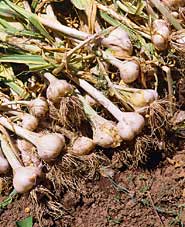
In late June, when most of the crop has brown leaves, Aaron begins to harvest with a sturdy spading fork. He is careful to avoid hitting the wire mesh beneath the plants (gophers will quickly find the holes). Although tradition dictates that the heads should be laid on the ground to dry, Aaron's garlic doesn't stay in the field for even a few minutes, it goes straight to a custom-built drying shed.
Cure garlic for two to three weeks in a cool, dark place, like a basement, garage, or garden shed where the average temperature ranges from 55° to 65° F and the humidity is 40 to 60 percent. The heads will be at their flavor peak for 2 to 3 months after curing, though still usable for up to six months.
Once the foliage has dried, dig up the garlic, rub all loose soil off the outside of each head, stripping some of the papery skin if you must. To prevent rotting and spoilage, don't remove so much skin that the cloves show through. Clip off the all-brown foliage, leaving 8 to 14 inches of stalk. Tie three to five stalks into a cluster and hang in a cool, dry, dark location that has good air circulation.
Just-harvested garlic tastes very different from fully cured. According to Aaron, Freshly harvested garlics all taste about the same, but after a month the variations in taste become noticeable. Aaron, who routinely eats 6 to 8 cloves of raw garlic a day, also uses it to prepare dozens of dishes, many laden with 20 to 30 raw or cooked cloves of the potent herb.
Asked about the most important thing he is learned in 10 years of growing garlic, Aaron replies: I knew before I ever planted garlic that different varieties had different sizes, colors, shapes, and numbers of cloves per head, but I now know that there's a real distinction in the flavors of different varieties. I had to eat my way to this discovery. In his experience, the flavor differences last for two to three months after curing.
Aaron is not one who rests on his laurels in retirement nor on his garlics! While planting last fall, he increased his collection of specialty garlics from 75 to 81 varieties and added four more 40-square-foot boxes. To Calvin Klein, Obsession is a perfume; to Chester Aaron, it's garlic.
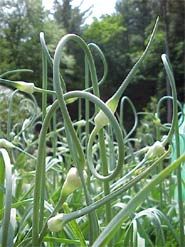
There are two basic kinds of garlic, hardneck and softneck. Hardnecks (H) are considered the more primitive, wild form. They are generally easier to peel and offer a wider span of tastes. They produce a central stalk that you should remove soon after it appears so that heads reach full size. Softnecks (S) tend to be hotter, have a narrower range of flavor, and usually produce larger heads that last longer in storage.
'Artichoke' (S): Very adaptable. Named for how the cloves curl up around the core of smaller cloves just as the leaves of an artichoke curve up around its core.
'Asian Tempest' (S): One of the newer best-flavored and hottest varieties.
'Bogatyr' (H): Stays usable longer than most varieties of any type.
'Brown Saxon' (H): Stays usable longer than most softnecks.
'California Early' (S): Mild and slightly sweet flavor.
'California late' (S): Spicy hot.
'Carpathian red' (H): A hardneck variety that's sturdy and strong.
'Chet's Italian red' (S): A very mild variety.
'Creole red' (S): Good looking and good flavored, it's one of the top choices in most tastings. Does very well in Gulf Coast weather.
'Duganskij' (H): A mellow, moderately hot, and long-storing variety.
'German red' (H): Hot-flavored and tasty. A good choice for cold-winter regions.
'Inchelium red' (S): Large heads and hotter than otherwise comparable 'Chet's Italian Red'.
'Pitarelli' (H): A variety that stays usable longer than most softnecks.
'Siberian' (H): Flavorful and good in cold climates.
'Spanish roja' (H): Medium-sized cloves peel easily and offer medium-hot flavor. One of top choices in many garlic taste-offs.
A frequent contributor, Robert Kourik gardens near Chester Aaron in Occidental, California. Kourik was honored by the Garden Writers Association with a Quill & Trowell for this article in 1999.
Photography by National Gardening Association and Suzanne DeJohn/National Gardening Association
 Victory Seed Company has all the seeds you want for your best garden in 2024.
Victory Seed Company has all the seeds you want for your best garden in 2024.
For 25 years, the family-owned Victory Seed Company has provided the highest quality vegetable, herb and flower seeds to families across the country. We are passionate about providing you the best seeds available that give excellent germination, robust plants, and the harvest you want. With a catalog of over a thousand varieties, we have everything, and our prices are the kinds that we'd want to pay. We have hundreds of yesterday's heirloom vegetables, as well as today's award winning hybrid selections. Get to know us by visiting our website and browsing through our online vegetable seed catalog.